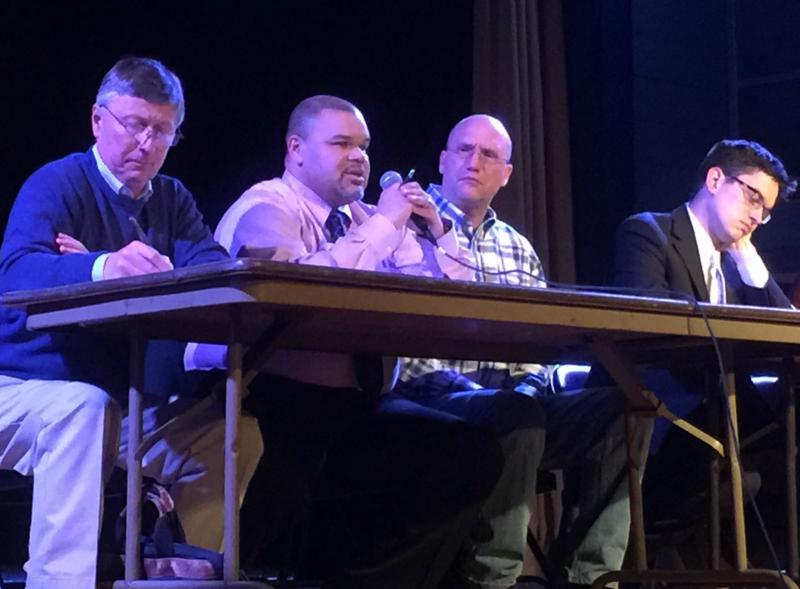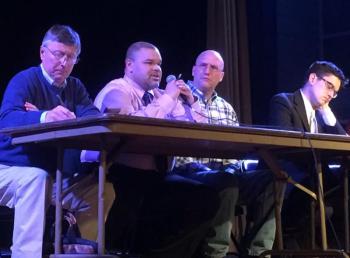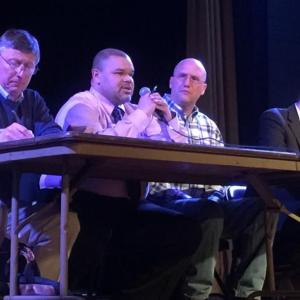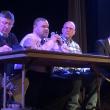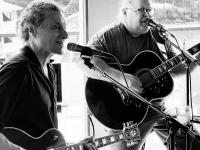CMP promises investigation into power surges
At 3 a.m. on Thanksgiving Day, 220 volts of electricity came into the home of Brian and Diane Howe of Summit Road in Boothbay Harbor. This overload caused their water heater, furnace, and all other major appliances to burn out.
“We were told by CMP that a tree branch must have come down,” Brian Howe said. “But there was no branch and the police and fire department said no branches had fallen.”
“Now every time the power goes out, we're scared,” Diane Howe said.
According to Howe, he sent all the required information into CMP for damages, but his claim was denied.
The Howe family isn't alone. Several other residents complained about power surges coming through the power lines and causing overloads and fires at the meeting with Central Maine Power representatives on Feb. 11 at the Opera House.
One of those speaking included Kate Rice, who lost her home in a Christmas Day fire.
“These surges are what caused our fire. We lost our home, our pets, everything we owned,” Rice said. “I am scared to death every time the power goes out now because I'm worried that every time it comes back on, it will cause a fire.”
Maine State Fire Marshals said after the fire on Dec. 25 that there may have been a power surge, or that there may have been a malfunction with the outlet or with the refrigerator.
Multiple attempts to reach the Maine State Fire Marshal’s office to confirm the specific cause of the fire were unsuccessful as of press time.
“We live across from the hospital (St. Andrews), and on Nov. 2 there was a huge power surge,” Boothbay Harbor resident Diane Reed said. “We lost several appliances and I have never experienced anything like that in all the time I've lived here. There were sparks across the counter tops and smoke through the house. It's lucky I was home.”
What are your options?
Timothy Schneider, the Maine public advocate, and Kiera Finucane, consumer adviser in the office of the public advocate, also attended the meeting. They were there to explain the rights and options of community members when problems arise with utilities.
1. According to Schneider, the first step is to contact the utility company. As obvious as this might seem, he said many people who contact the public advocate have not taken this first step.
2. The next step is to contact the Public Utilities Commission's Consumer Assistance Division (CAD) by phone at 1-800-452-4699 or by using its online complaint form. An investigation will be started to determine if the utility complied with state law, commission rules, and the company's posted terms and conditions. This process does not award reimbursement for damaged items.
3. The next step is to contact the Office of the Public Advocate, which can provide additional assistance and guidance for matters that CAD is unable to resolve. The Office of the Public Advocate can be reached at 207-287 2445 or opa@maine.gov.
4. The last step is to file a 10-person complaint with the Public Utilities Commission. This can be done if the problem involves at least 10 customers who each have separate accounts with the utility. The Office of the Public Advocate can assist by advising if a 10-person complaint is an appropriate mechanism to obtain relief, offer feedback on a drafted complaint, and assist in filing with the commission.
Three representatives came from CMP to listen and respond to concerns. They included John Carroll, the director of corporate communications, Lloyd Hendrix, the service center manager at the Brunswick office, and Tom Sansouci, who is the supervisor of linemen who work in this area and oversees construction and maintenance. The meeting was moderated by State Sen. Chris Johnson.
Hendrix promised to start an investigation into the incidents the next day, with a crew coming down to the Boothbay area.
“We need to figure out if these incidents are related or unrelated,” Carroll said. “We need to isolate and identify each incident and see if there is a common cause and if we can and should do something about it.”
“I don't think they (community members who spoke) care about what's causing it, they just want it to be fixed,” Johnson said. “This is beyond the norm, appliances blowing and houses burning.”
Other residents spoke about downed trees that block emergency services, the danger of power losses in housing developments such as Campbell Creek Village and Bay Landing, and the fact that power outages seemed to last longer than in previous years.
“The most frequent complaint I get is that power outages used to last two or three hours, and now last 10 hours or more,” Boothbay Selectman Chuck Cunningham said. “Has this area been put on a lower priority with the loss of our hospital?”
“No, your status as a community has not changed,” Sansouci said. “I still consider St. Andrews a hospital.”
Some residents complained about the treatment they had received when contacting CMP for help.
“I was told what happened was an 'act of God, and that isn't our problem’,” Diane Howe said. “No care of concern at all.”
Hendrix was distressed to hear about this treatment, and gave his direct line to all who attended the meeting so they could contact him: 207-721-8031.
“That should never happen again,” he said.
Holly Stover, who was instrumental in arranging the CMP meeting, stressed the need for the issue to be resolved as soon as possible.
“You need to send real people down here. Not suits, real guys, to take a look around,” Stover said.
Stover said that despite the number of people on the peninsula now, many more visit it during the summer season.
Carroll said the total number of outages in the area for 2014 was 111. This number includes all outages; the way CMP defines a single outage, it can refer to a single customer without power or an area without power. The total number is a combination of both types of reported outage.
He explained that since Boothbay and Boothbay Harbor are on a peninsula, there are not as many connections points and power is more likely to go out.
“In some areas, power is coming from multiple directions and has more points where it can get through even if one fails,” Carroll said. “On a peninsula, power is coming from just one direction.”
He also explained the causes of the power outages from 2014: 62 percent were tree-related, with 58 percent of those being caused by branches outside of their designated trim areas (areas they are allowed to cut back); 14 percent were caused by animals; three percent from motor vehicle accidents; six percent were equipment failures; and 15 percent were from unknown causes. Unknown causes can include animal outages if the crew can't find the animal, or branch issues if the branch is moved before the crew gets there.
Carroll stressed the importance of staying away form downed power lines, and that is was more helpful if nothing is moved until the crew gets there.
Related: Christmas fire determined accidental
Event Date
Address
United States

